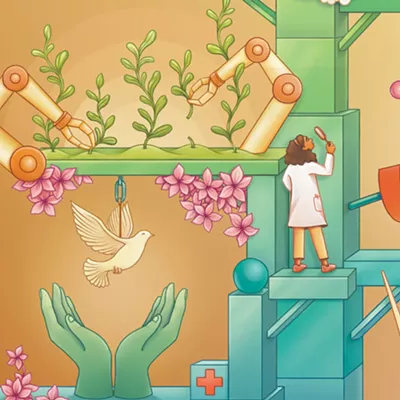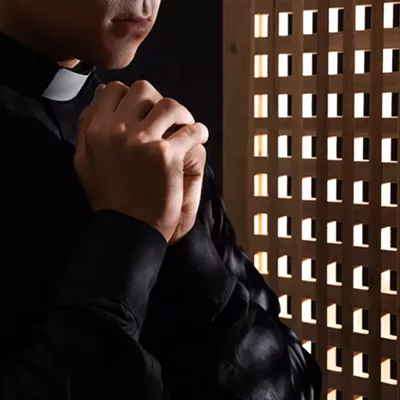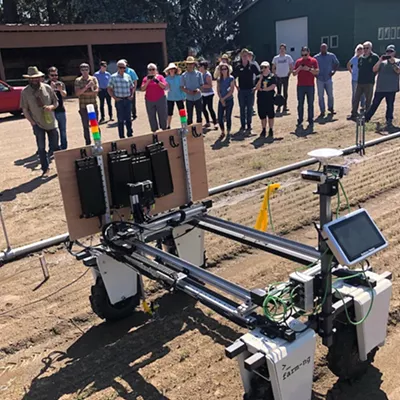To wander into Keiko Hara's new installation at the MAC is to feel as if you've just come across a Tea Room of the subliminal and subconscious. There is the same quiet reverence, the same panels made of wood and paper, but everywhere there is a kaleidoscope of language, color, texture and various fluctuations of light. It's not surprising, of course, that this Japanese-born artist would have elements of Japanese culture in her work. What is interesting is that despite the fact that she has become one of the biggest names in contemporary Northwest art, Hara's work defies easy categorization -- even for the artist herself.
"I like being between the disciplines," Hara says. "Between various different techniques. My work is not particularly Japanese, nor is it particularly American. And it's not just about images, there is also text and texture. They are not particularly abstractions either. I don't know what I can call [my work]. It is just what I do."
Keiko Hara was born in what is now North Korea during World War II. Her family returned to Japan in 1945, and Hara grew up steeped in postwar Japanese culture. Although she showed early promise as an artist, she was encouraged by her family, teachers and friends to tread a more traditionally feminine path.
"By the time I was in high school, I was already really serious about the arts. I went to see a local artist, and I told him, 'I want to go to Tokyo and become an artist.' He said, 'Frankly, you have no possibilities. One, you are a girl. And you would have to be amazingly beautiful enough that a man would want to support you. Number two, he must have enough money to support you all of your life,'" Hara remembers, laughing. "Actually there were three things, but I don't remember number three. Anyway, I went to Tokyo."
To support her art, Hara found work as a teacher and almost followed a completely different path. (She still teaches, now at Whitman College in Walla Walla.) While still in Japan, she grew interested in the new field of art therapy and experimented with different ages and abilities of students. She was especially excited by what art therapy was able to do for her students with cerebral palsy, but knew she'd have to pursue her education in the United States if she wanted to go any further. Once she landed in New York and visited the Metropolitan Museum, the MOMA and numerous galleries of contemporary art, she knew she wanted to focus solely on her own art.
"I had a teacher in Japan," Hara recalls, "who, before I came here said, 'You are doing a very valuable thing to help handicapped children with art therapy,' he said to me. 'But art therapy, other people can do. Your art, only you can do.'"
Her career as an artist subsequently seemed guided by the benevolent spirit of circumstance. When trying to decide where to go for her BFA degree, she opened up a map of the United States and let the names choose her destination for her.
"I opened up the map and I saw 'Mississippi,'" she laughs. "I had read Mark Twain and those words -- 'Mississippi,' 'Tennessee' -- they sounded so beautiful to me."
Her position at Whitman was also shaped by happenstance -- she meant to apply to a college in the other Washington -- but in her work, there has been a definite sense of the deliberate and a profound awareness that her roots are right below the surface.
Her early fascination with human psychology and how a viewer interacts with art is very much in evidence in her new show at the MAC. "Topophilia -- Imbuing/Seasons" is an installation piece consisting of four wood-framed spaces. Hara designed it so that each room represents a different sort of environment: hot, cold, wet, dry.
"I wanted to explore the idea of 'seasons' in terms of every possible world of human experience," she says. "In every part of the world, people have to deal with cold, hot, wet, dry, and also, these are essential survival conditions. There is a sort of exciting 'life or death' element to the work, too."
As you move through the piece, you become part of the art through the use of mirrors and of words beamed from a slide projector. There is something dreamlike about not only the installation, but other pieces in the show, including the haunting and evocative "Verse-Imbuing in Yellow" and the paper works "Imbuing/Maru." In the latter, Hara works shreds of fabric -- worn by people from other cultures -- into handmade papers. There are bits of text, different alphabets and the recurring motif of circles.
"I use various kinds of marks, marks I have printed or drawn, text from old books, marks and bits of paper from different parts of the world," she says. "For the viewer, there is this effect with the environment and the light, both artificial and natural light, of becoming a part of the work. The projected marks embrace the viewer."
Hara's work is a study in dialogue -- there is delicacy and strength, gravity and play, freedom and restraint. Running throughout is a subtle and intuitive intelligence. It's almost as if Hara documents communication evolving by returning to its most basic elements.
"With these shreds of fabric and these marks, I'm trying to go back to the essential human language. I'm trying to give a sense of language before we were forced to make sense," she says. "I am corroborating with all sorts of ethnic histories, different aesthetics and cultures. And in this I can go beyond my own marks."
Publication date: 08/19/04
















